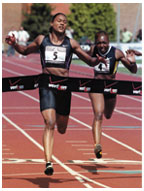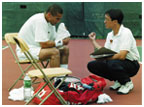|
June 6, 2001 Sports Track
and field gains on competition Bulls
market
Tigers' new coach is an ace Sports Web Exclusives! Matt Golden's From the Cheap Seats column Track
and field gains on competition
It is the world's oldest sport, dating back to ancient Greece and the very first Olympics. During the past 100 years, it has produced many of America's greatest and most renowned sports icons, including Jim Thorpe, Jesse Owens, Wilma Rudolph, and Carl Lewis. But, aside from the 1996 Olympics in Atlanta, track and field had disappeared from the consciousness of most American sports fans during the 1990s. The sport's top performers were competing almost exclusively in Europe at that time, and track's national governing body, U.S.A. Track and Field (USATF), was facing financial bankruptcy. Searching for an escape from its dubious future, USATF named Craig Masback '77, the 1980 U.S. indoor mile champion and former American record holder at 2,000 meters, as its CEO in 1997. Masback, who had previously cofounded Inclyne Sports, a marketing and sports television production company, immediately identified the organization's most pressing need. "Track did nothing to market itself for more than 30 years," Masback explained. "So other sports were able to come from behind and surpass track in terms of business sophistication." Masback's first step in rebuilding USATF was to pinpoint the organization's key assets. He determined those to be America's preeminence in the sport (the U.S.A. Track and Field team won 10 Olympic gold medals in Sydney last summer, six more than any other nation); the popularity of American athletes like Michael Johnson, Marion Jones, and Maurice Green; and track and field's status as the number-one participatory sport nationally on the high school and junior high levels. Using those assets, Masback developed a two-pronged strategy for the marketing of track and field within the U.S. He instituted a "top-down" approach to increase the national exposure and popularity of America's premier athletes. In 1999, USATF launched the Golden Spike Tour, a series of meets on domestic soil that feature the sport's elite competitors. (One such event was held at Princeton on May 12 and featured Olympic medalists Marion Jones, Angelo Taylor, Nick Hysong, Melissa Morrison, Terrence Trammell, Passion Richardson, Antonio Pettigrew, Lawrence Johnson, Ken Brokenburr, and Jerome Young.) In addition, Masback has landed new and increased sponsorship from General Motors, Visa, Nike, Xerox, First USA, Adidas, and several other major corporations. As part of their partnership with USATF, participating companies have used track and field athletes as spokespersons in advertising and promotional campaigns. The second phase of Masback's marketing campaign adopted a "bottom-up" approach, which Masback referred to as "our focus on the grassroots/participatory side of our sport." USATF has developed several programs aimed at expanding participation on the youth, high school, and club levels. The organization also hopes to help grow the ever-increasing adult running population, in part through programs with its corporate sponsors. Though pleased by USATF's recent strides, Masback remains concerned by what he views as a damning misperception. The prevalence and continued use of performance-enhancing drugs, like anabolic steroids, casts a murky shadow over the sport. "Our greatest challenge remains performance-enhancing drugs," Masback explains. "We were the first major sports organization in the world to conduct regular, out-of-competition testing. . . . The fallout is that because we have actually pursued and caught cheating athletes, we are branded a 'drug-ridden' sport. Meanwhile, sports that do not even test, such as Major League Baseball, don't have a 'drug problem'." Though still trying to improve its image, USATF is enjoying a prosperity that sets it apart from many other professional sports leagues. "The investment models of many sports are looking very questionable while track and field goes through a business rebirth," Masback reveals. "We have more than doubled our yearly revenues since I started, and we have quadrupled our sponsor revenues. "Our 2001 TV ratings
show a 15 percent increase at a time when all other major sports
are losing audience share," Masback adds. In fact, USATF television
ratings currently exceed those of the National Hockey League, Major
League Soccer, and the Women's National Basketball Association.
"It's ironic," says Masback, "but the world's oldest sport is the sports business world's newest opportunity." By M.G.
Bulls
market Princeton had already beaten Wake Forest, and now it was halftime of Seton Hall-Clemson, the second game of the 1997 Jimmy V. Classic at the Meadowlands. Dick Vitale was taking time away from his ESPN duties to play a game of horse against some unsuspecting fan randomly picked from the crowd. "Look at me," Vitale told the house. "I have a lefty hook. I have a righty hook. I'm Goodrich." The "Goodrich" in question was Steve Goodrich '98, then Princeton's center. No explanation was needed, though. Everyone knew who "Goodrich" was. His was a big name in college basketball that year, and by the time that season ended his Tigers held a top-10 national ranking. Fast forward more than three years, to that same court in the same arena. Goodrich is still wearing number 30, only this time it says "Bulls" across the front of his jersey. And he is doing something on this night in March 2001 that he didn't even do in that game against Wake Forest. He is grabbing seven rebounds. The next night, he steps out of the locker room and heads toward the court at the First Union Center in Philadelphia. He smiles easily at some familiar faces. He signs autographs. He talks to the media. He goes to warm up. He looks for all the world like he belongs here. And that's what he's trying to prove - that Steve Goodrich, the 1998 Ivy League Player of the Year and a late-season acquisition of the Chicago Bulls, belongs in the National Basketball Association. "He's a great kid and a total professional," said Bulls general manager Jerry Krause. "He's smart as a whip. He's an outstanding passer. He's a very good guy to have around." Of course, Krause's kind words hardly came with a guarantee, but Goodrich's basketball odyssey has taught him that there are no guarantees. Since leaving Princeton in 1998, he has played in three countries, been the last roster cut of both the Philadelphia 76ers and the Bulls, and played in the International Basketball League for the woeful and now-defunct Baltimore Bayrunners. "There are a ton of guys who can play in the NBA," Goodrich said. "You have to make the most of your opportunity. The more time you spend on the court with NBA players, the less intimidating it becomes. It's just basketball, and you have to rely on the things you can do well." Goodrich played in 12 games with the Bulls, averaging 1.6 points and 1.8 rebounds in 11 minutes per game. Playing as a small forward, he showed he could hit a three-pointer, pass, and rebound. Against Philadelphia he was the first Bull off the bench. "He was the hardest cut for me personally," said Bulls coach Tim Floyd, who had to release Goodrich during the preseason because players with guaranteed contracts filled the Bulls' roster. "I value who he is as a player and a person. There's a place for guys like that on your roster. He does exactly what you tell him to do in every situation. He's more athletic than he appears on defense. He's a ball-mover. . . . I thought he did fine for us." The Bulls, the youngest team in the NBA, face an uncertain future. Chicago finished the season with the worst record in the league at 15-67, and no player's position on the roster is etched in stone. In the complex world of NBA rosters, Goodrich's future depends as much on other people's performance (and contracts) as his own. Still, he played well enough to earn an invitation to training camp next season, and his ability, work ethic, and intelligence could earn him an opening-day spot with the Bulls. "It's been great,"
Goodrich said. "I learned I'm not the only one who can't guard
Vince Carter [the Toronto Raptor superstar]. Sometimes the hardest
thing is to get your foot in the door. Once you do that, now you
have to prove you belong." By Jerry Price Jerry Price is is the assistant director of sports information at Princeton.
Richard Barron was named head coach of the Princeton women's basketball team on May 8. He replaces interim coach Kevin Morris and hopes to rebuild a Tiger program that suffered through a 2-25 campaign last season. Barron comes to Princeton
from the University of the South in Sewanee, Tennessee, where he
compiled a 77-48 record in five years as the school's head coach.
Prior to his arrival, the University of the South posted 10 consecutive
losing seasons.
Tigers' new coach is an ace
Glenn Michibata watched, learned from, and competed against the best during his 10 years on the Association of Tennis Professionals (ATP) Tour. Michibata is now the head coach of the Princeton men's tennis team, and the current Tigers are reaping the benefits of their new coach's experience. "When I was nearing the end of my career, I knew I wanted to remain in the sport and coach," Michibata says. "I thought I'd be able to give back some of what I've learned to young players." So, after two years of traveling as a coach on the pro tour and three years as an assistant at the University of Southern California, Michibata was ready to set down roots in Princeton when the Tigers' former coach, David Benjamin, retired last spring. Michibata says, "I've really found what I like in collegiate tennis. I enjoy the team aspect." Originally from Canada, Michibata played on the ATP Tour from 1983 to 1993 and was a 14-time member of Canada's Davis Cup team. In 1991 he and partner Grant Connell were ranked number one in the world in doubles. His career highlights include an appearance in the Australian Open doubles final and semifinal appearances at Wimbledon and the French Open. Also ranked number 48 in the world in singles play in 1991, Michibata competed against Jimmy Connors, Ivan Lendl, Stefan Edberg, Boris Becker, Andre Agassi, and Pete Sampras among others. Since taking over the Princeton program last summer, Michibata has preached the same doctrine that he applied throughout his own playing career: "Preparation is 100 percent of the game," he says. "The competition is the reward. It's simply a time for execution. If you don't do the groundwork to prepare, then it's just not going to happen for you." Michibata hopes to continue
the success that Princeton enjoyed during Benjamin's tenure - the
Tigers posted a 346-154 mark from 1975-2000. "I think the first
year went very well," explains Michibata, whose team finished
second in the Ivy League with a 5-2 record (10-9 overall). "Playing
under a new coach in the first year can be very tough. Players are
used to a certain style and system, and I think their response was
commendable. I'm disappointed we didn't win the league, but we worked
very hard, and to me, that's success. Sports tend to be very result-oriented,
and people have it ingrained in their minds that winning and losing
are the only measures of success. I want our players to focus on
the process, and if they do that, the wins will follow." By Mark Gola Mark Gola is a frequent contributor to PAW.
|
||||||

 Marion
Jones ran at Princeton on May 12 during a Golden Spike Tour event.
(Photo by Beverly Schaffer)
Marion
Jones ran at Princeton on May 12 during a Golden Spike Tour event.
(Photo by Beverly Schaffer) Photo
by Frank Wojciechowski
Photo
by Frank Wojciechowski Glenn
Michibata, right, who likes the team aspect of collegiate tennis,
encourages John Portlock '01, left. (Photo by Beverly Schaffer)
Glenn
Michibata, right, who likes the team aspect of collegiate tennis,
encourages John Portlock '01, left. (Photo by Beverly Schaffer)